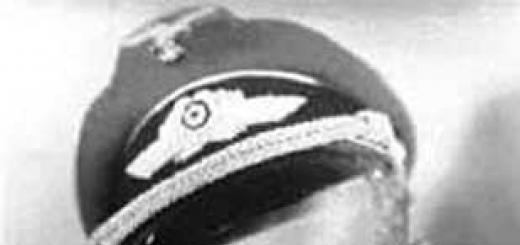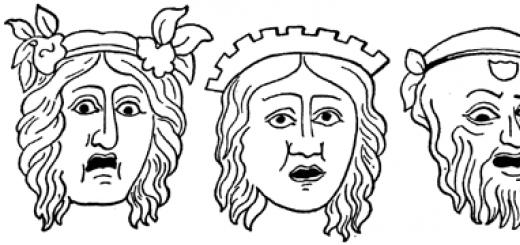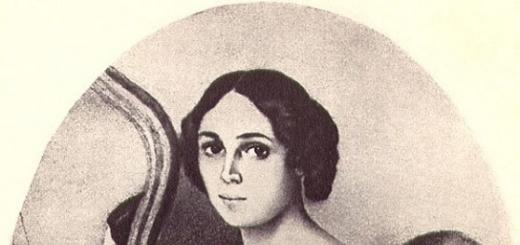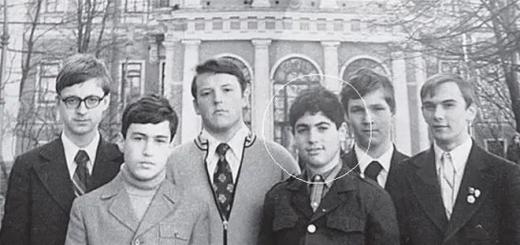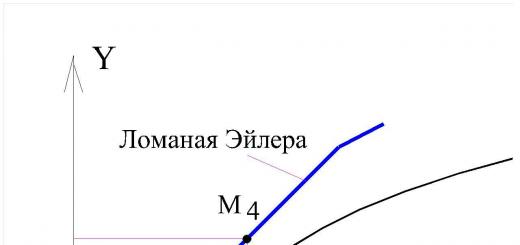Lev NikolaevichGumilyov is a Russian historian, ethnologist, Doctor of Geographical and Historical Sciences. He is the author of the doctrine of ethnic groups and humanity as biosocial categories. studied ethnogenesis, its bioenergetic dominant, which he called passionarity.
Lev Gumilyov was the only child in the marriage of the famous poets Nikolai Gumilyov and Anna Akhmatova. During Akhmatova’s pregnancy, the couple were in Italy; almost no information has been preserved about this trip. Returning to Russia, Nikolai and Anna spent the entire second half of July and the beginning of August 1912 in Slepnev, Bezhetsk district - the estate of the poet’s mother Anna Ivanovna Gumilyova. The birth of an heir was an expected event, because the marriage of Gumilyov’s elder brother, Dmitry, turned out to be childless, and at a village gathering the peasants were promised to forgive their debts if a boy was born.
Lev Nikolaevich entered the Leningrad State University, Faculty of History, in 1934. However, after completing his first year, he was arrested for the first time. Soon Lev Gumilyov was released, but he never managed to graduate from the university. Already in his 4th year, in 1938, he was again arrested for participation in a student terrorist organization. Gumilev was sentenced to 10 years in the camps. Later his fate was softened. Lev Nikolaevich should have served a 5-year sentence in Norilsk. After this time, in 1943, he worked for hire in Turukhansk and near Norilsk. Then Gumilyov went to the front.Gumilev Lev Nikolaevichfought as an anti-aircraft gunner,he got thereto Berlin.
In 1949Gumilevwas arrested again. He was released only in 1956 and then completely rehabilitated. It turned out that no crime was found in Gumilyov’s actions. In total, Lev Nikolaevich was arrested 4 times. In total, he had to spend 15 years in Stalin’s camps.
For the first three years of his freedom, Gumilyov was a senior researcher at the Hermitage Library. At this time, the scientist was processing his own working drafts, written in the camps. In the second half of the 1950s. Lev Nikolaevich communicated a lot with orientalist Yuri Roerich, the founder of Eurasian theory Pyotr Savitsky and Georgy Vernadsky.
Gumilyov's first articles were published in 1959. The scientist had to struggle for a long time with the prejudice and suspicion of the scientific community towards his personality. When his materials finally began to appear in print, they immediately earned universal recognition. The historian’s articles appeared in the publications “Bulletin of Ancient History”, “Soviet Ethnography”, “Soviet Archeology”. "Xiongnu"

Lev Gumilyov’s first monograph was the book “Xiongnu,” the manuscript of which he brought to the Institute of Oriental Studies in 1957 (it was published three years later). This work is considered the cornerstone of the researcher’s work. It was in it that the ideas that Gumilyov later developed throughout his scientific career were first laid down. This is the opposition of Russia to Europe, the explanation of social and historical phenomena by natural factors (including landscape) and the earliest references to the concept of passionarity.
Xiongnu
The work “Xiongnu” received the greatest recognition from Turkologists and Sinologists. The book was immediately noticed by the main Soviet sinologists. At the same time, Gumilev’s first monograph already found principled critics. Lev Nikolaevich’s further work also evoked directly opposite assessments.

Rus' and the Horde
In the 1960s, the topic of Russian medieval history became the main one in the works published by Lev Gumilyov. Ancient Rus' interested him from many sides. The scientist began by conducting a study of “The Tale of Igor’s Campaign,” giving it a new dating (the middle, not the end of the 12th century).
Then Gumilyov took up the topic of Genghis Khan's empire. He was interested in how a state emerged in the harsh steppe of Mongolia that conquered half the world. Lev Nikolaevich dedicated the books “Xiongnu”, “Xiongnu in China”, “Ancient Turks”, “Search for a Fictitious Kingdom” to the Eastern hordes.

Passionarity and ethnogenesis
The most famous part of the scientific heritage left by Lev Gumilyov is the theory of ethnogenesis and passionarity. The first article on this topic was published by him in 1970. Gumilyov called passionarity the super-intense activity of a person in his desire to achieve a certain goal. The historian superimposed this phenomenon on the doctrine of the formation of ethnic groups.
Lev Gumilyov’s theory stated that the survival and success of a people depends on the number of passionaries in it. The scientist did not consider this factor to be the only one, but defended its importance in the process of formation and displacement of ethnic groups by competitors.
The passionary theory of Lev Gumilyov, which caused serious scientific controversy, stated that the reason for the emergence of a large number of leaders and extraordinary personalities are cyclical passionary impulses. This phenomenon is rooted in biology, genetics and anthropology. As a result, superethnoses arose, Lev Gumilyov believed. The scientist’s books included hypotheses about the reasons for the origin of passionary impulses. The author also called them energy impulses of a cosmic nature.

Contribution to Eurasianism
As a thinker, Gumilyov is considered a supporter of Eurasianism - a philosophical doctrine about the roots of Russian culture hidden in the synthesis of European and nomadic Asian traditions. At the same time, the scientist in his works did not touch upon the political side of the dispute at all, which markedly distinguished him from many adherents of this theory. Gumilyov (especially at the end of his life) criticized Western borrowings in Russia a lot. At the same time, he was not an opponent of democracy and a market economy. The historian only believed that the Russian ethnic group, due to its youth, lags behind the Europeans and therefore is not ready to adopt Western institutions.
The author's unique interpretation of Eurasianism was reflected in several works written by Lev Gumilyov. “Ancient Rus' and the Great Steppe”, “Black Legend”, “Echo of the Battle of Kulikovo” - this is just an incomplete list of these works. What is their main message? Gumilyov believed that the Tatar-Mongol yoke was actually an alliance of the Horde and Rus'. For example, Alexander Nevsky helped Batu, and in return received support in the fight against the Western crusaders.
Khazaria
One of Gumilyov’s most controversial works is “The Zigzag of History.” This essay touched on the little-studied topic of the Khazar Khaganate in the south of modern Russia. In his work, Gumilev described the history of this state. The author dwelled in detail on the role of Jews in the life of Khazaria. The rulers of this state, as is known, adopted Judaism. Gumilyov believed that the Kaganate lived under the Jewish yoke, which ended after the campaign of the Kyiv prince Svyatoslav Igorevich.

Last years
With the beginning of perestroika, poems by Nikolai Gumilyov reappeared in the Soviet press. His son was in contact with Literaturnaya Gazeta and Ogonyok, helped collect materials, and even read his father’s works at public events. Glasnost increased the circulation of books and Lev Nikolaevich himself. In the last Soviet years, many of his works were published: “Ethnogenesis”, “Ethnogenesis and the Biosphere of the Earth”.
In 1990, Leningrad Television recorded a dozen and a half lectures by the historian. This was the pinnacle of his lifetime popularity and fame.
On June 15, 1992, Lev Nikolaevich Gumilev died at the age of 79.
https://www.syl.ru/article/281987/new_gumilev-lev-...-biografiya-interesnyie-faktyi

Gumilyov created his theory, trying to understand why wave-like and rapid ethnic processes were observed in the Great Steppe during the Middle Ages and antiquity. Indeed, they were often, in one way or another, associated with changes in climatic conditions. Therefore, to some extent, scientists’ linking landscape and ethnicity is justified. Nevertheless, the “theory of ethnogenesis” lost its credibility as a result of Gumilev’s absolutization of the role of natural factors. The term “passionarity”, which belonged to Lev Nikolaevich, began to live its own life. The scholar used it to refer to the original ethnic activism.
Another work that shows the historical views of L.N. Gumilev and in which he applied his theory of ethnogenesis is a work on nomads and Slavs. On the title page of “Ancient Turks” were the following words: “I dedicate this book to our brothers - the Turkic peoples of the Soviet Union.” Gumilyov was the first to raise his voice in defense of the originality of Tatar-Mongolian history and culture, which had previously been invariably denied the right to equal value with European or Chinese history. Gumilyov was the first to speak out against the Eurocentric “black legend” about the Tatar-Mongol yoke, about the eternal enmity of the nomads of the Steppe with the farmers of the Forest.
It is Lev Nikolaevich who has the honor of rethinking, on the basis of strict scientific facts, the role played by the Turkic and Mongolian peoples in the history of Russia. In his works, he proves that there was no hatred, but a system of dynamic, extremely complex relationships with an invariable feeling of sympathy and respect for each other’s ethnic identity.
Gumilev believed that the peoples of the Great Steppe did not have pathological cruelty and a tendency to destroy cultural achievements. He points out among the positive qualities of the nomads that the representatives of the Great Steppe have always professed the belief that “they are not judged for prowess in battle, and traitors are not forgiven.”
L. N. Gumilyov formed an evidence-based concept of the natural brotherhood of the Russian people with the Turkic and Mongolian peoples. All this remains largely unknown and incomprehensible to the European consciousness to this day. Obviously, this determines the small and often incorrect amount of information not only about nomadic peoples - the Huns, Turks, Mongols, but even about the more famous settled peoples of Asia - China, India, etc. Until the XV-XVI centuries. Europeans knew nomads only from their periodic invasions of Europe itself. Therefore, they perceived nomadic peoples as nothing other than their enemies. L. N. Gumilev was the first to speak out against such a Eurocentric perception of the history of nomadic peoples in his works. At one time, academician N. I. Conrad, in his articles “The Middle Ages in Historical Science”, “On the Meaning of History”, as well as in letters to J. Toynbee, gave a fairly methodologically justified answer to Eurocentrism. Similar opinions are found among Western researchers. Let's take the statements of the American researcher Rudi Paul Lindner. In his voluminous study “What was a nomadic tribe?” he writes: “Historians do not like nomads... . Primary historical sources emphasize this hostility with their general derogatory attitude: their authors, being sedentary people, also saw nomads as predators and described them from a safe distance. Why should we put forward this evidence in the absence of alternative sources that embrace the nomadic perspective? And further: “Why did the horse archers have to preserve the archives? Paper was always heavy and would prevent the mobility, range and speed of horses. In short, traveling ease gave the nomads a military advantage, but it also placed their history in the hands of their sedentary victims."
The modern creative community perceives the scientific heritage of this great scientist differently. In the minds of some, he was not in the full sense a Turkic orientalist. Not having sufficient knowledge of medieval eastern sources in the original, presenting the material in a more arbitrary form than was customary in classical historical-orientalist scholarship, he often heard criticism from his colleagues - nomadic scholars and orientalists. In his works, L. N. Gumilyov abandoned the already usual strict adherence to data from sources, and from scrupulous textual work on medieval manuscripts and texts. He saw the historian’s task differently: “History requires special abilities, coverage of phenomena, special vision and intuition, to which knowledge of languages is not directly related. The work of the historian, who establishes connections between events, begins where the work of the orientalist philologist, whose task is to establish the existence of the events themselves, ends.”
In the scientific heritage of L.N. Gumilyov, one of the main places is occupied by research on the history of the Turkic and Mongolian worlds, on the history of nomadism in general. Considering the problems of Turkology raised in the works of famous orientalists L. Cohen, N. A. Aristov, G. E. Grumm-Grzhimailo, V. V. Radlov, V. V. Bartold, A. N. Bernshtam, A. N. Kononov , O. Pritsaka, L.N. Gumilyov developed important methodological approaches in general to the history of nomadism. In any of Gumilev’s works “Hunnu”, “Hunns in China”, “Ancient Turks”, “Search for a fictional kingdom”, “Discovery of Khazaria”, “A Millennium around the Caspian Sea” the “secrets” of nomadic statehood are revealed. For example, if L. Cohen and N.A. Aristov saw Turkic society as a “society of individuals and clans”, insufficiently assessing its military and political organization, V.V. Radlov assigned the leading role in the formation of a nomadic state to the “influence of leaders”, and O. Pritsak outlined the general picture of the “creation of nomadic empires,” then in Gumilev’s works we see a reasoned denial of the proposed interpretations and a new vision of the problem of nomadic statehood. He did not agree with the limited understanding of the formation of a nomadic empire put forward in Pritsak’s work “How did the steppe empire arise?” In his opinion, firstly, steppe associations (i.e. states) arose not in one way, but in several ways, and secondly, the election of a khan is less common than inheritance of power. Further. The destruction of noble families was carried out only by Genghis Khan, but it was not typical for the Turks, Uighurs and Huns.
Most modern Eurasians were formed in one way or another under the influence of Lev Nikolaevich Gumilyov. For example, M.D. Karateev in his article “Rus and the Tatars” generally adheres to the provisions put forward by Lev Nikolaevich and develops them. In his opinion, this “... is quite understandable and psychologically understandable: the great Russian people, accustomed to victory, having fallen under the heavy heel of the conquerors, of course, could not feel anything but hatred for them, and in those years any attempt to give an impartial assessment of the national character of the Tatars and the characteristics of their rule.”
A Tatar could only be “filthy” - a wild, treacherous, inhuman robber and rapist. And such an image of him, which, according to M.D. Karateev, is far from the truth, has become traditional in our literature and in the ideas of the Russian people.
As for the Tatar-Mongol yoke, he recognizes its severity, but points out that it led to unity caused by the need to overthrow this yoke with common forces.
Recently, the concept of Gumilyov and his followers in one form or another has even penetrated the pages of textbooks. And since most textbooks present official scientific theories, we can conclude that Eurasian views on the ethnic history of nomads are spreading in modern Russia.
So, this is, for example, “Essays on the history of the peoples of Russia in antiquity and the early Middle Ages.” Its authors are Dmitry Sergeevich Raevsky, Doctor of Historical Sciences, chief researcher at the Institute of Oriental Studies of the Russian Academy of Sciences; specializes in the field of archaeology, history and culture of the Scythian era, semantics of the fine arts of Europe in antiquity, and Vladimir Yakovlevich Petrukhin, Doctor of Historical Sciences, leading researcher at the Institute of Slavic Studies of the Russian Academy of Sciences; specialist in the field of archeology and ethnoculture of the history of East and Northern Europe in the early Middle Ages.
This textbook is an experience in a consistent presentation of ethnic history - the history of the peoples (ethnic groups) of Russia in antiquity and the Middle Ages. The authors focus on the defining events for the ethnic history of Europe: the formation and differentiation of large ethnolinguistic communities, primarily ethno-European into other ethnic groups, the Scythians and other peoples of antiquity, the Turks and Slavs in the early Middle Ages.
The most interesting is Chapter X: “Slavs and nomads in the early Middle Ages: the problem of ethnocultural synthesis.” As we see, the name itself speaks not of confrontation, but of the interaction of the Slavic and nomadic worlds. philosophical system" (which is now commonly called the word "mentality").
Rus' turned out to be the heir to the social and ethnocultural mechanism that was “launched” during the period of Khazar rule. The experience of interacting with nomads allowed the Eastern Slavs to survive the Mongol-Tatar invasion and the Horde yoke. Thus, the interaction of ethnic groups that formed in the medieval era was not reduced to a unidirectional process of domination and subordination, conflict and assimilation: the spectrum of this interaction was wider, and the most valuable historical lesson can be considered the mutual exchange of achievements of different cultures.
In recent years, a lot has been written and spoken about the idea of a “Eurasian union”. These are Russian authors N. Trubetskoy, N. Dugin, A. N. Podberezkin, K. Zatulin, Kazakh philosopher A. Nysanbaev, Kyrgyz writer Ch. Aitmatov, and many others. The authors, in a hurry to preach the ideas of the “EurAsEC”, effectively use the mistakes and blunders made by liberals at the initial stage of independence, especially in economic and social policy, causing nostalgia for the former imperial greatness, as well as using the anti-globalization sentiments that take place in the mass consciousness. Others believe that “there are prospects for integration, but the conditions are not ripe,” since independent states are far from freed not only from economic dependence, but also from many “birthmarks” of the former imperial habit.
Everyone knows that in the post-Soviet Eurasian space, only Russia is a powerful political force capable of uniting the great Eurasian steppe around itself. Judging by the statements of individual Russian authors, the “ideology of Eurasianism” is interpreted by them as the “ideology of sovereignty,” as one of the forms of reunification of the country through the creation of various national institutions. This not only alarms many, but also leads to the conclusion that it is impossible in the near future to create an equal multilateral civilized union between Russia and its former satellites (satelle), now the main buyers of its export goods, energy dependent on it. Thus, “Eurasianism or “EurAsEC” is a completely undeveloped topic in scientific terms. We do not find a specific answer to this question either from Nikolai Trubetskoy, Pyotr Savitsky, Vernadsky, or Lev Gumilyov. Only Genghis Khan subjugated all the tribes of the Eurasian steppes and turned this steppe empire into one state with a strong military-political organization. This experience was repeated, but in a different capacity, during the creation of the USSR. History does not yet know a third such example. In this we see the amorphousness and uncertainty of this phenomenon from a historical point of view.
Comment on the statement of L.N. GUMILEV, who noted that the fight against Mamai? ? 1380 Muscovites, Suzdalians, Yaroslavs, Vladimirs, Kostroma residents went, and after the Kulikovo fields the Russians returned.
Answers:
Before the Battle of Kulikovo, Rus' was divided into several “states”. everyone was for himself. and after the battle the people united and became one country.
Similar questions
- Underline the phrases in which the rules of lexical compatibility are violated. Write down the correct option. 1) The film will help viewers get an opinion about Estonia. ........................................................ ........................................... 2) At school, great importance is paid to the study of foreign languages. ........................................................ ......................................... 3) The exhibition made a lasting impression. ........................................................ ................................... 4) You need to draw conclusions from what you read.
- Choose the correct verbs to rewrite the sentences with the same meaning. 1. It is necessary for you to phone Martin. (must/might) 2. It is possible that Ann will be here this evening. (can/might) 3. It is not necessary for you to wait. (mustn"t/don"t have to) 4. It is not good for people to watch TV all the time (mustn"t/shouldn"t) 5. Do you want me to open a window? (shall/will) 6. It is important for people to cooperate. (may/should) 7. John smoked when he was younger. (can/may) 8. It is possible that it will rain. (can/may) 9. Alan knows how to speak Spanish. (can/could) 10. I would like you to help me. (can/could)
- Option 2. For each question, select only one answer that you consider the most complete and correct. 1.Where does food digestion begin in spiders? a) in the stomach b) in the intestines c) in the oral cavity d) outside the body 2. The chitinous cover of arthropods is a skeleton, since it a) does not stretch b) serves as a place for muscle attachment c) is located in the body cavity d) protects animals from drying out 3. With complete transformation, the following develop: a) locusts and mole crickets b) bees and grasshoppers c) cockroaches and bugs d) cockroaches and white butterflies 4. The body is clearly divided into the head, chest and abdomen in: a) crayfish b) tick c) karakurt spider d) flies 5. Crustaceans do not include: a) woodlice; b) daphnia; c) cyclops; d) water striders. 6. The following are capable of living underwater: a) spider; b) silver spider; c) tarantula spider; d) karakurt. 7. Tracheas are the respiratory organs of: a) dragonflies b) pinworms c) crayfish d) oysters 8. The arachnoid glands of the cross spider are located on a) cephalothorax b) abdomen c) chest d) head 9. Insects breathe with the help of a ) air sacs b) lungs c) trachea d) pulmonary sacs 10. The complexity of the organization of arthropods compared to annelids is manifested in the presence of: a) protective coloring of the body b) nervous system c) digestive and circulatory systems of organs d) exoskeleton and articulated limbs 11. List 3 characteristics of the class of arachnids. A) Include three orders B) Breathe with pulmonary sacs and (or) trachea B) Closed circulatory system D) Have 3 pairs of walking legs E) Dioecious, internal fertilization E) Hermaphrodites 12. What structural features are characteristic of crustaceans: a) body parts: head, chest, abdomen b) 5 pairs of walking legs c) the presence of arachnoid glands d) 4 pairs of walking legs e) body parts: cephalothorax, abdomen f) presence of antennae 13. Indicate three characteristics of the class of insects. A) Open circulatory system B) Pulmonary respiration B) Closed circulatory system D) Tracheal respiration E) Development only with complete transformation E) Development with complete and incomplete transformation 14. Establish a correspondence between the structural feature and the class for which it is characteristic: structural features classes of arthropods a) body sections: head, thorax, abdomen 1) arachnids b) 3 pairs of walking legs 2) insects c) presence of arachnoid glands d) 4 pairs of walking legs e) body sections: cephalothorax, abdomen f) presence of antennae a b c d e 15. The order Lepidoptera (butterflies) includes (choose three answers): A) aphids; B) ladybug; B) indoor moth; D) cabbage whites; D) Asian locust; E) birch moth. 16. Find errors in the given text, correct them, indicate the numbers of the sentences in which they are made, write down these sentences without errors. 1. The class of arachnids is the most numerous class of the phylum arthropods.2. The body of arachnids has a cephalothorax and abdomen.3. Ticks have a fused body.4. There are three pairs of walking legs. 5. All spiders lead a terrestrial lifestyle. 17. Insert into the text “Body of arthropods” the missing terms from the proposed list, using numerical notations. Write down the numbers of the selected answers in the text, and then enter the resulting sequence of numbers (according to the text) in the table below. BODY OF ARTHROPODS. The body of arthropods consists of ____(A). Representatives of this type have sections: ____(B) and abdomen or head, chest and abdomen. On the ventral side of the body there are jointed legs. The number of legs in representatives of arthropods is ____(B). Most ____(D) have wings on the dorsal side of their body. 1) element 2) different 3) spider 4) insect 5) identical 6) segment 7) anterior 8) cephalothorax
Alexander Firsov
3. Ethnogenesis in three stages
“If anyone proposes a more elegant and more convincing concept to explain the facts listed in this book, then I will bow my head to him with respect. And vice versa, if someone declared my conclusions final and not subject to revision and further development, then I would not agree with him.” L. Gumilyov, "From Rus' to Russia ».
I will try to take the liberty of offering, if not a more elegant, then a simpler concept of the development of ethnic groups that have formed into a state, than the concept of Lev Gumilyov.
3.1. Passionarity development schedule
Below is the original graph of Lev Gumilyov, depicting the development curve of passionarity over time, on which is superimposed the development graph of any living organism:
And here is a graph of the development of the Spanish Empire from the article “The Rise and Fall of the Spanish Empire”:
In the theory of transient processes, such a graph is called a “burst”:
In practice, to analyze such a transition process, it is often divided into three parts: growth (development), maturity (stability) and aging (decline). This is done in a variety of areas, for example, in the enterprise life cycle development model:
Two main things need to be said about Gumilyov’s schedule:
- The graph was created by Gumilyov without the use of digital data - on a whim, so it is either a gift from above (the hand of the writer was guided by providence) or is an attempt to depict a standard graph of the development of a living organism in a scientific form.
- Basically, the schedule does not consist of six phases, but only three simpler ones:
- Growth is almost linear. Over time, it slows down due to the appearance of interference, due to which the growth curve passes the horizontal state;
- A stable area, when the forces of growth and the forces of counteraction are approximately equal, growth is no longer visible, but fall is not visible either;
- The period of decline when the decline becomes prevalent and stable.
- Basically, the schedule does not consist of six phases, but only three simpler ones:
As we can see, the graph is practically no different from the development graph of any living organism.
3.2. Developmental chart of a living organism
The peculiarity of Gumilyov’s graph is that in its form it completely coincides with the development graph of a living organism.
In the development of an ethnos, as in any living (biological) system, development first proceeds upward (growth, development, youth), then a certain horizontal section follows (flourishing, maturity), and then a decline occurs (aging, decline).
Gumilyov himself admits that his curve is an ordinary curve of an ordinary transition process found everywhere in nature:
“The curve we propose is asymmetrical, discrete and anisotropic over time. It is well known to cybernetics as the curve describing the combustion of a fire, the explosion of a powder magazine and the withering of a leaf.” L. Gumilev "Ethnogenesis and biosphere of the Earth ».
Neither in the combustion of a fire, nor in the explosion of a powder warehouse, nor in the development of a sheet at the completion of the process, there are such phases as “breakdown,” “inertial,” “obscuration,” and “memorial.”
Gumilyov's use of these phases only confuses the study of the process of ethnogenesis.
3.3. Three main stages of system development
And these three stages (growth, flourishing, decline) are the same in the development of any biological or social system.
The growth period for humans is divided into additional stages (adolescence, youth).
Gumilev called the growth stage the development phase, he called the maturity stage the acmatic phase, but in the decline stage he identified as many as 4 separate phases: breakdown, inertia, obscuration, memorial.
There is nothing surprising. As a person who dealt mainly with disappeared ethnic groups, Gumilyov practically dealt only with declines in the development of an ethnic group, so he studied this stage more carefully than others and tried to distinguish 4 phases in it.
The fact that Gumilyov drew many small ups and downs on the graph can be considered Gumilev’s individual vision of the standard development schedule of any biological system.
3.4. Three main stages of development of a living organism
If you look at living organisms or social structures, they all develop according to the same scenario: at first the organism (structure) grows almost non-stop. Then, in the body (social structure), certain elements begin to accumulate that do not interfere with growth, but begin to restrain it from uncontrollable and excessive development. And then these same forces begin not only to restrain growth, but become interfering and leading to death.
In this case, the restraining force is most often not an external factor, but an integral part of the organism itself - its internal regulator, which at the end of the organism’s life, from the function of a regulator, as the growth forces weaken, becomes a potential source of death of the organism.
If you understand what two forces interact in the body, then there are always two of them.
One force is the cause of growth, and the second force, born of the first, becomes the cause first of a slowdown in growth and then of death.
If you understand the interaction of the two main forces of development, then you can understand the entire course of development, maturity and dying.
Quite simply and clearly, Gumilyov’s graph can be presented in the form of a trapezoid, consisting of three parts:
A. The first part of the trapezoid - growth
On this part of the trapezoid there is almost linear growth, due to the fact that the growth forces prevail over the opposing forces. At this time, there are no growth-inhibiting forces in the system. The growth is almost non-stop, in the first approximation it is linear, and in the second approximation it is exponential.
Intensive growth is underway.
B. Second part of the trapezoid – flourish
At this stage, the trapezoid has a horizontal section parallel to the time axis. This is the area of maximum growth – flourishing. By this time, forces appear in the system that restrain growth, but do not prevent the system from existing and developing.
In this section, the growth forces and counterforces are in an equilibrium state and balance (compensate) each other.
B. Third part of the trapezoid - decline
The third part of the trapezoid is almost straight (more precisely, exponential) - decline. This is a process of extinction when the opposing forces have won.
The forces of growth are continually weakened by opposing forces over time. The decline ends in death.
We will analyze these three important stages of ethnic development.
I repeat, only those ethnic groups that have formed a separate state will be analyzed, and almost all ethnic groups go through this.
3.5. A small retreat
If we look at any family as a union of two people, then we can almost always distinguish three types of families:
In which the man rules,
In which a woman rules,
In which there is no head of the family and the main issues are resolved jointly.
The line between the three types of families is not clear, hardly noticeable, but it exists, and, as philosophers would say, this line is material, i.e. exists independently of our consciousness.
Similarly, you can analyze any biological or social system consisting of a pair of elements: either one prevails, or the symbiosis is equal.
3.6. Another option
In this case, the body grows until the moment when the forces of growth and the forces restraining growth are equalized.
For some time, the system exists in time without developing or degrading. But over time, the forces of degradation in such a system win.
In this case, the symbiosis dies when the body, under the influence of these microbes/microorganisms/forces, becomes so weak that it can no longer resist.
In this case, death usually befalls both the organism itself and its offspring.
Note: The adult body contains 10 times more bacteria than cells.
3.7. What two forces determine the development of an ethnic group and a state?
“The nature of labor processes, consumption, wars, the creation of a state or its fall are the same objects of ethnographic research as wedding rites or ritual ceremonies.” L. Gumilyov “Biosphere and impulses of consciousness.”
If we are talking about the ethnic group that formed the state, then the answer to the question about the driving force of passionarity is in these two words: ethnic group and state.
3.7.1. First stage - growth
At the first stage, the ethnic group grows without much need for government control. But, as they grow, members of the ethnic group understand that without state governing bodies it is impossible to self-regulate or resist external influences.
At this stage, the ethnos itself tries to create state bodies that gradually develop, become stronger and sooner or later begin to no longer obey the ethnos, but already coexist with it on equal terms. In this case, the state and ethnic group move to the second stage - maturity (flourishing).
3.7.2. Second stage - blossoming
At the second stage, the state and the ethnic group coexist as a symbiosis, helping each other and interacting as equals.
But sooner or later, the state apparatus understands how it can control an ethnic group, extracting more and more benefits from this for itself, and gradually “pulling over the blanket” of power, economic and political levers.
Sooner or later, a moment comes when power begins to prevail over ethnicity.
Power takes over, and the imbalance in relations between power and ethnicity becomes irreversible.
The ethnic group and the state are moving into the third stage of development - aging.
3.7.3. The third stage is aging
The moment when power and the state apparatus begin to prevail over society becomes the beginning of the last stage in the existence of an ethnos. At this stage, everything begins to move towards the death of both the ethnic group and the state formed by it.
Let us consider the three stages of ethnogenesis in some detail. We will focus on the relationship between ethnicity and power.
3.8. Geography and the origin of the ethnic group
According to Gumilyov, for the emergence of an ethnic group, something is needed that changes the essence of the people at the geographical and genetic level. Unfortunately, very few facts are provided to support such a conclusion. Gumilev in his works provides only some references and illustrations.
The role of geography should not be denied - it is important. But without the economic factor, there will be no development of the ethnic group.
The rapid development of an ethnic group is not possible without the economic factor. It is at the intersection of geographical and economic factors that an ethnic group is born with its own special character and corresponding lifestyle - a matrix of behavior.
3.9. Economic factor as a reason for the formation of an ethnic group
“Ethnic groups... are always connected with the natural environment due to their active economic activity. The latter manifests itself in two directions: adapting oneself to the landscape and adapting the landscape to oneself.” L. Gumilev "Ethnogenesis and biosphere of the Earth ».
“At some point, an established (historically) group of people, or consortium, appears on the historical arena, quickly developing and forming its ethnic identity and self-awareness (“us and not us”, or “us and others”). Finally, it takes on a social form appropriate to the time and enters the broad historical arena, often beginning territorial expansion... any process of ethnogenesis begins with the heroic, sometimes sacrificial actions of small groups of people (consortia), which are joined by the surrounding masses, and quite sincerely.” L. Gumilyov, "Ethnogenesis and biosphere of the Earth ».
In this statement, Gumilev is partially right, since a group of people forming an ethnos begins territorial expansion mainly only in literary sources, but in practice, first of all, it begins the economic use of the territory.
And people most often join passionaries not due to a special “induction” generated by genes, but as a result of specific words and arguments.
“When talking about possible sources of passionary impulses, we did not discard only one hypothesis - cosmic radiation.” L. Gumilev, “Ethnogenesis and biosphere of the Earth.”
In Lev Gumilyov's works, the basis for the beginning of the growth and development of an ethnos is considered to be a certain combination of influence from space on the genes of people living in a certain territory, and the influence of nature. Moreover, Gumilev comes to this conclusion as if logically, but by the method of “by contradiction,” rejecting all other options over and over again. This approach is not a direct proof of the first (cosmic) factor, but rather an attempt to adjust the logic to the desired result.
The importance of the second factor (natural) is very important. Adapting the landscape to oneself is also important, and adapting oneself to the landscape is also important. But all this is not enough.
Gumilyov missed the third factor, without which there can be no development of the ethnos. This factor is an economic factor, which consists in a gift that nature gives to a person, and to which a person (ethnic group) finds the key.
This gift is the opportunity, due to certain natural resources or features of the landscape and climate, due to a certain way of existence of an ethnos (ideas, matrix of behavior), to provide food not only for the ethnos itself, but also for a certain number of people. An ethnos begins to develop if people joining the ethnos accept its matrix of behavior as their own.
Such a gift allows an ethnic group to both exist independently in a certain territory and carry out a certain exchange of goods with neighboring ethnic groups, sometimes annexing them.
Any ethnic group at the beginning of its development has such a gift from nature, which, during the formation of the ethnic group, determines its matrix of behavior. And the matrix of behavior will subsequently determine the existence of the ethnic group.
Nature gifts peoples in different ways. These are the silt deposits of the Nile for Egyptian agriculture. This is the broad prairie for the United States. These are herds of sea animals for the Eskimos. This is the floodplain of the Lena River for the Yakuts. These are the watershed massifs of the taiga for the Evenks. These are the waterways along the fjords for the inhabitants of Scandinavia. These are steppe expanses for Kazakhs and Kalmyks. This is the path from the Varangians to the Greeks for the Russians, etc.
Based on this gift, peoples form a matrix of their behavior, which allows them to survive and receive maximum material benefits.
(To be continued).
